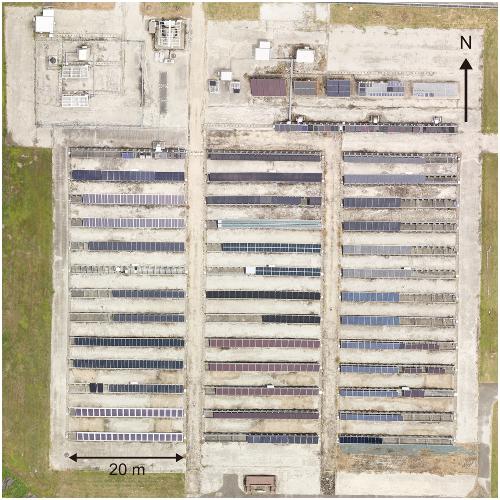当前位置:
X-MOL 学术
›
Prog. Photovoltaics
›
论文详情
Our official English website, www.x-mol.net, welcomes your
feedback! (Note: you will need to create a separate account there.)
Annual degradation rates of recent crystalline silicon photovoltaic modules
Progress in Photovoltaics ( IF 8.0 ) Pub Date : 2017-07-10 , DOI: 10.1002/pip.2903 Tetsuyuki Ishii 1 , Atsushi Masuda 2
Progress in Photovoltaics ( IF 8.0 ) Pub Date : 2017-07-10 , DOI: 10.1002/pip.2903 Tetsuyuki Ishii 1 , Atsushi Masuda 2
Affiliation

|
Long‐term reliability and durability of recently installed photovoltaic (PV) systems are currently unclear because they have so far only been operated for short periods. Here, we investigated the quality of six types of recent crystalline silicon PV modules to study the viability of PV systems as dispersed power generation systems under operating conditions connected to an electric power grid. Three indicators were used to estimate the annual degradation rates of the various crystalline silicon PV modules: energy yield, performance ratio, and indoor power. Module performance was assessed both with indoor and outdoor measurements using electric measurements taken over a 3‐year period. The trends in the results of the three indicators were almost consistent with each other. Although the performance of the newly installed PV modules decreased by over 2% owing to initial light‐induced degradation immediately after installation, little to no degradation was observed in all the PV modules composed of p‐type solar cells over a 3‐year operation period. However, the PV modules composed of n‐type solar cells clearly displayed performance degradation originating from the reduction of open‐circuit voltage or potential‐induced degradation. The results indicate that a more continuous and detailed outdoor actual investigation is important to study the quality of new, high‐efficiency solar cells, such as heterojunction, interdigitated back contact solar cells, and passivated emitter rear cells, which are set to dominate the PV markets in the future. © 2017 The Authors. Progress in Photovoltaics: Research and Applications published by John Wiley & Sons Ltd.
中文翻译:

最近的晶体硅光伏组件的年降解率
目前尚不清楚最近安装的光伏(PV)系统的长期可靠性和耐用性,因为到目前为止它们仅在短时间内运行。在这里,我们研究了六种新型晶体硅光伏组件的质量,以研究光伏系统作为分散发电系统在连接到电网的运行条件下的可行性。三个指标用于估算各种晶体硅PV组件的年降解率:能量产量,性能比和室内功率。使用三年内进行的电气测量,通过室内和室外测量来评估模块性能。这三个指标的结果趋势几乎彼此一致。尽管新安装的光伏模块的性能由于安装后立即发生的初始光诱导降解而下降了2%以上,但是在3年的运行期内,由p型太阳能电池组成的所有光伏模块几乎没有观察到退化。但是,由n型太阳能电池组成的PV组件清楚地显示出性能下降的原因是开路电压的降低或电位引起的降低。结果表明,进行更连续和详细的户外实际研究对于研究新型高效太阳能电池(如异质结,叉指背接触太阳能电池和钝化发射极后部电池)的质量非常重要,这些电池将主导光伏发电未来的市场。©2017作者。但是,由n型太阳能电池组成的PV组件清楚地显示出性能下降的原因是开路电压的降低或电位引起的降低。结果表明,进行更连续和详细的户外实际调查对于研究新型高效太阳能电池(如异质结,叉指背接触太阳能电池和钝化发射极后部电池)的质量非常重要,这些电池将主导光伏发电未来的市场。©2017作者。但是,由n型太阳能电池组成的PV组件清楚地显示出性能下降的原因是开路电压的降低或电位引起的降低。结果表明,进行更连续和详细的户外实际调查对于研究新型高效太阳能电池(如异质结,叉指背接触太阳能电池和钝化发射极后部电池)的质量非常重要,这些电池将主导光伏发电未来的市场。©2017作者。高效能太阳能电池,例如异质结,叉指背接触太阳能电池和钝化发射极后部电池,将在未来主导光伏市场。©2017作者。高效能太阳能电池,例如异质结,叉指背接触太阳能电池和钝化发射极后部电池,将在未来主导光伏市场。©2017作者。光伏技术的进展:研究与应用,John Wiley&Sons Ltd.出版。
更新日期:2017-07-10
中文翻译:

最近的晶体硅光伏组件的年降解率
目前尚不清楚最近安装的光伏(PV)系统的长期可靠性和耐用性,因为到目前为止它们仅在短时间内运行。在这里,我们研究了六种新型晶体硅光伏组件的质量,以研究光伏系统作为分散发电系统在连接到电网的运行条件下的可行性。三个指标用于估算各种晶体硅PV组件的年降解率:能量产量,性能比和室内功率。使用三年内进行的电气测量,通过室内和室外测量来评估模块性能。这三个指标的结果趋势几乎彼此一致。尽管新安装的光伏模块的性能由于安装后立即发生的初始光诱导降解而下降了2%以上,但是在3年的运行期内,由p型太阳能电池组成的所有光伏模块几乎没有观察到退化。但是,由n型太阳能电池组成的PV组件清楚地显示出性能下降的原因是开路电压的降低或电位引起的降低。结果表明,进行更连续和详细的户外实际研究对于研究新型高效太阳能电池(如异质结,叉指背接触太阳能电池和钝化发射极后部电池)的质量非常重要,这些电池将主导光伏发电未来的市场。©2017作者。但是,由n型太阳能电池组成的PV组件清楚地显示出性能下降的原因是开路电压的降低或电位引起的降低。结果表明,进行更连续和详细的户外实际调查对于研究新型高效太阳能电池(如异质结,叉指背接触太阳能电池和钝化发射极后部电池)的质量非常重要,这些电池将主导光伏发电未来的市场。©2017作者。但是,由n型太阳能电池组成的PV组件清楚地显示出性能下降的原因是开路电压的降低或电位引起的降低。结果表明,进行更连续和详细的户外实际调查对于研究新型高效太阳能电池(如异质结,叉指背接触太阳能电池和钝化发射极后部电池)的质量非常重要,这些电池将主导光伏发电未来的市场。©2017作者。高效能太阳能电池,例如异质结,叉指背接触太阳能电池和钝化发射极后部电池,将在未来主导光伏市场。©2017作者。高效能太阳能电池,例如异质结,叉指背接触太阳能电池和钝化发射极后部电池,将在未来主导光伏市场。©2017作者。光伏技术的进展:研究与应用,John Wiley&Sons Ltd.出版。











































 京公网安备 11010802027423号
京公网安备 11010802027423号